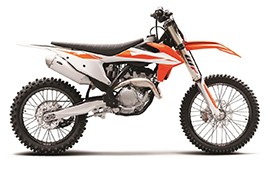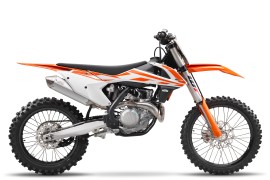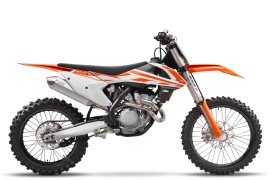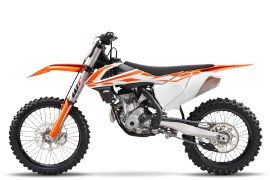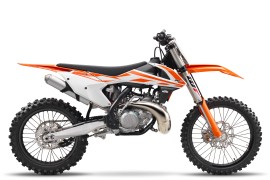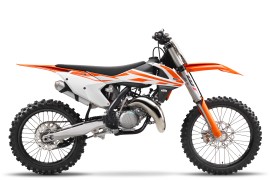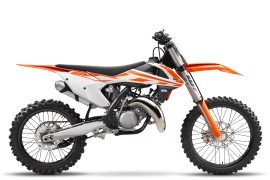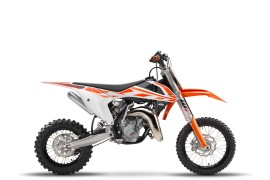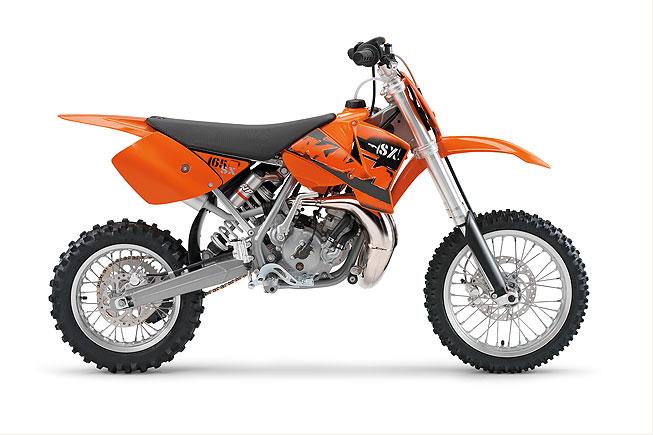KTM SX Models/Series Timeline, Specifications & Photos
First production year: 2006
For model year 2018 all models receive a generation changing update with KTM engineers targeting a further weight reduction that once again sets a clear benchmark in each class. In fact, in the higher capacity 450cc segment the KTM 450 SX-F is a lot lighter than its rivals.
All models in the KTM SX range have received major engine revisions over previous models. The KTM 250 SX-F and KTM 350 SX-F models enjoy a newly designed DS clutch, while all 4-strokes boast revised transmissions and a state-of-the-art Keihin engine management system with a reworked throttle body and improved electronics package.
The hugely successful 450 SX-F powerhouse has extremely compact dimensions, strong performance throughout the rev range and a low weight; this is the lightest 450 engine on the MX market. But that doesn’t mean it’s not a heavyweight in terms of muscle. Fitted with a single overhead camshaft cylinder head and the latest electronic fuel injection, it pumps out an unrivaled 62hp. With KTM’s engineers working tirelessly to increase service intervals, this super stroker has the latest engine management technology on board and confidently shoots both amateurs and pros to the top of their time sheets.
The engine of the 350 SX-F features a compact and very light (27.2kg) construction. Its DOHC (double overheard camshaft) design with lightweight titanium valves and DLC coated finger followers allows for lively but strong engine characteristics. Fitted with the latest electronic fuel injection system and electric starter, it has an extremely wide usable speed range, high performance and incredibly efficient rideability. The 350 SX-F engine shares the same layout as the one in the 250 SX-F, its playful handling similar to a 250 machine resulting mainly from reducing the moving masses to a minimum.
The 250 SX-F is fitted with a unique electric starter as standard, which is a clear advantage when it comes to crunch time in the heat of battle. A strong starter motor made by Mitsuba and the proven starter drive will fire up your track star time and time again at the push of a button.
The engine of the 250 SX has been known and respected for being the most powerful 2-stroke engine in its class. But we thought the segment could use an extra push and a solid statement: 2-strokes have a future at KTM. Their outstanding power-to-weight ratio, low cost and simplicity see to that. Putting our money where our mouth is, we gave the 250 SX engine an all new architecture with a new shaft arrangement for better mass centralization, a new cylinder with twin-valve controlled power valve, a new counter balance shaft for less engine vibrations, a 5-speed transmission and a hydraulically operated DDS clutch.
As of model year 2017, all KTM 2-stroke models are fitted with new MIKUNI TMX carburetors, replacing the Keihin products. This 38mm flat slide carb lives to provide smooth and controllable power all the way up to the limiter. And it’s less sensitive to different altitudes and temperatures, so you can pin it wherever, whenever.
The latest 125 SX engine is the most powerful and most competitive engine in its class; a clear statement that KTM is keen on keeping 2-stroke technology at the forefront of development. The secret to their success is an outstanding power-to-weight ratio, low costs and simplicity. This 125cm3 ripper has been developed with the latest KTM engineering know-how and the most advanced technology available.
The 65 SX is a fully-fledged piece of sports equipment for young pilots aged around 8 to 12 years with a body height of up to 1.60m. This year’s top student features revolutionary WP AER 35 front forks, cool graphics and a lot of detail improvements setting the standard in terms of power, riding dynamics, equipment and craftsmanship.
The 50 SX is a true KTM for young MX riders aged from around four to 10 years old, up to a body height of 1.30m. A genuine motorcycle that, like its bigger siblings, is produced with quality components that make the 50 SX the first choice as a stepping stone into the MX world or for the first racing step on the ladder.
The KTM 65 SX was a motorcycle introduced by KTM in 1998, developed specifically for young riders. The small bike was powered by a 64cc two-stroke single-cylinder liquid-cooled engine married to a six-speed manual transmission.
In 2010, the bike received several improvements, such as a new ignition cover with improved sealing and a new engine case with improved reliability.
In addition, the Austrian manufacturer introduced a factory racing SXS version with increased power from 16 to 19.5 hp, including an FMF exhaust system, a holeshot device, an aluminum ignition cover, and a tuned carburetor.
In 2016, the Austrian motorcycle manufacturer launched the KTM 65 SX, a motorcycle that offered a good time for young riders without worrying about all the complicated trinkets that adult bikes come with.
Visually, the bike had standard features, such as a high-mounted front fender, a wide handlebar, a one-piece seat, an under-seat-mounted exhaust system, a dual-sided swingarm, and wire-spoke wheels shod with Bridgestone off-road tires.
The bike was built around a Chromium-Molybdenum central-type frame with a 35 mm inverted Marzoki fork on the front and a WP shock absorber on the rear, offering optimum handling capabilities.
As for the braking power, the bike's wheels were fitted with a 200 mm disc on the front and a 160 mm disc on the rear, providing optimum stopping power.
